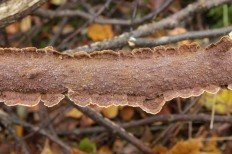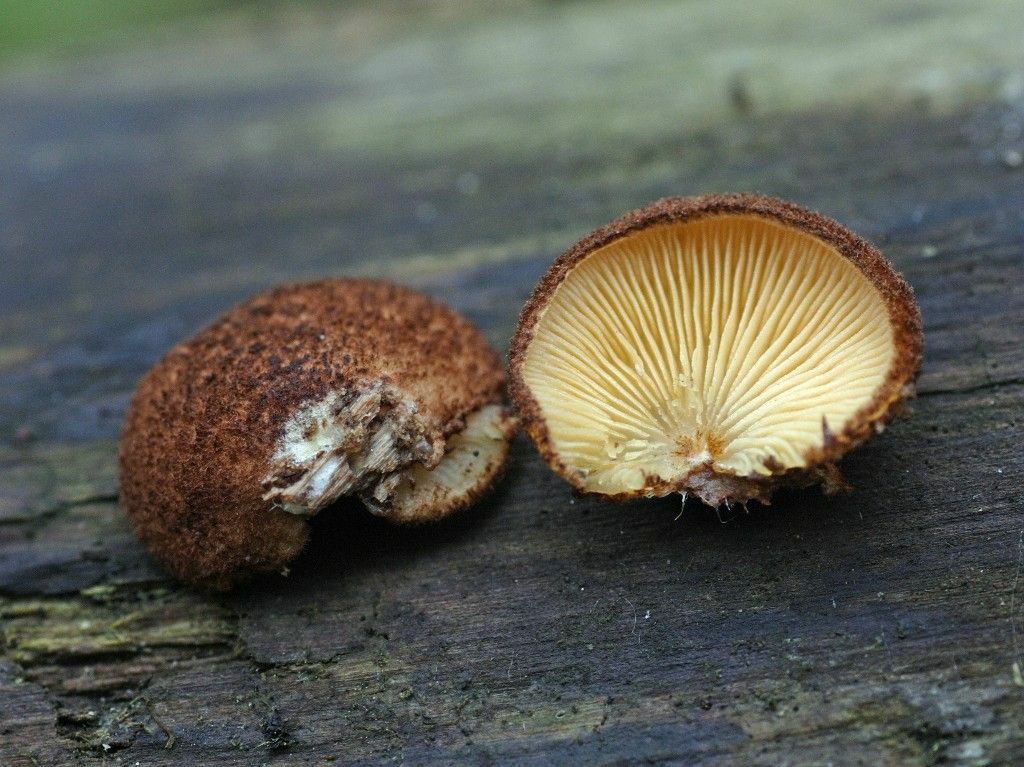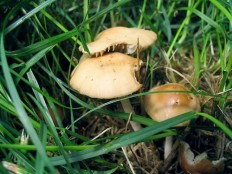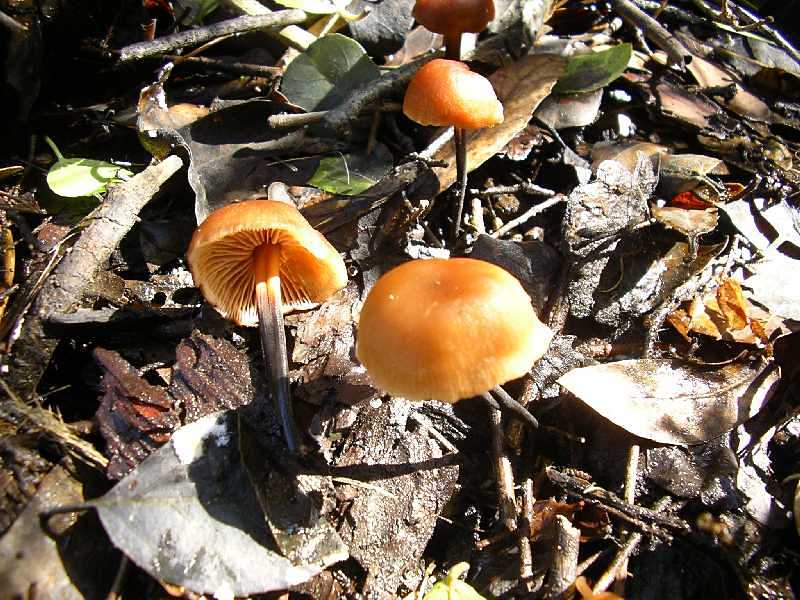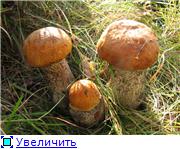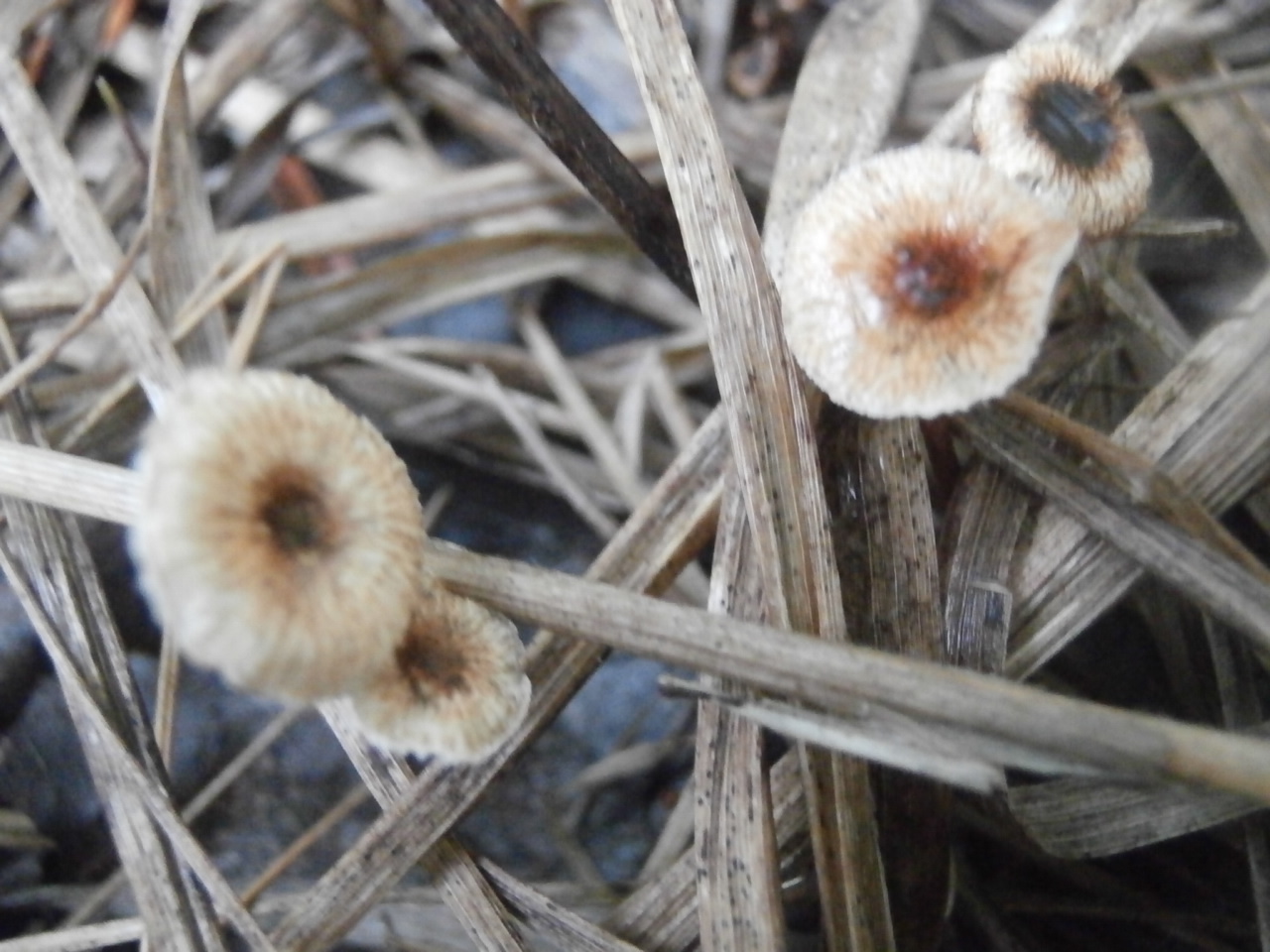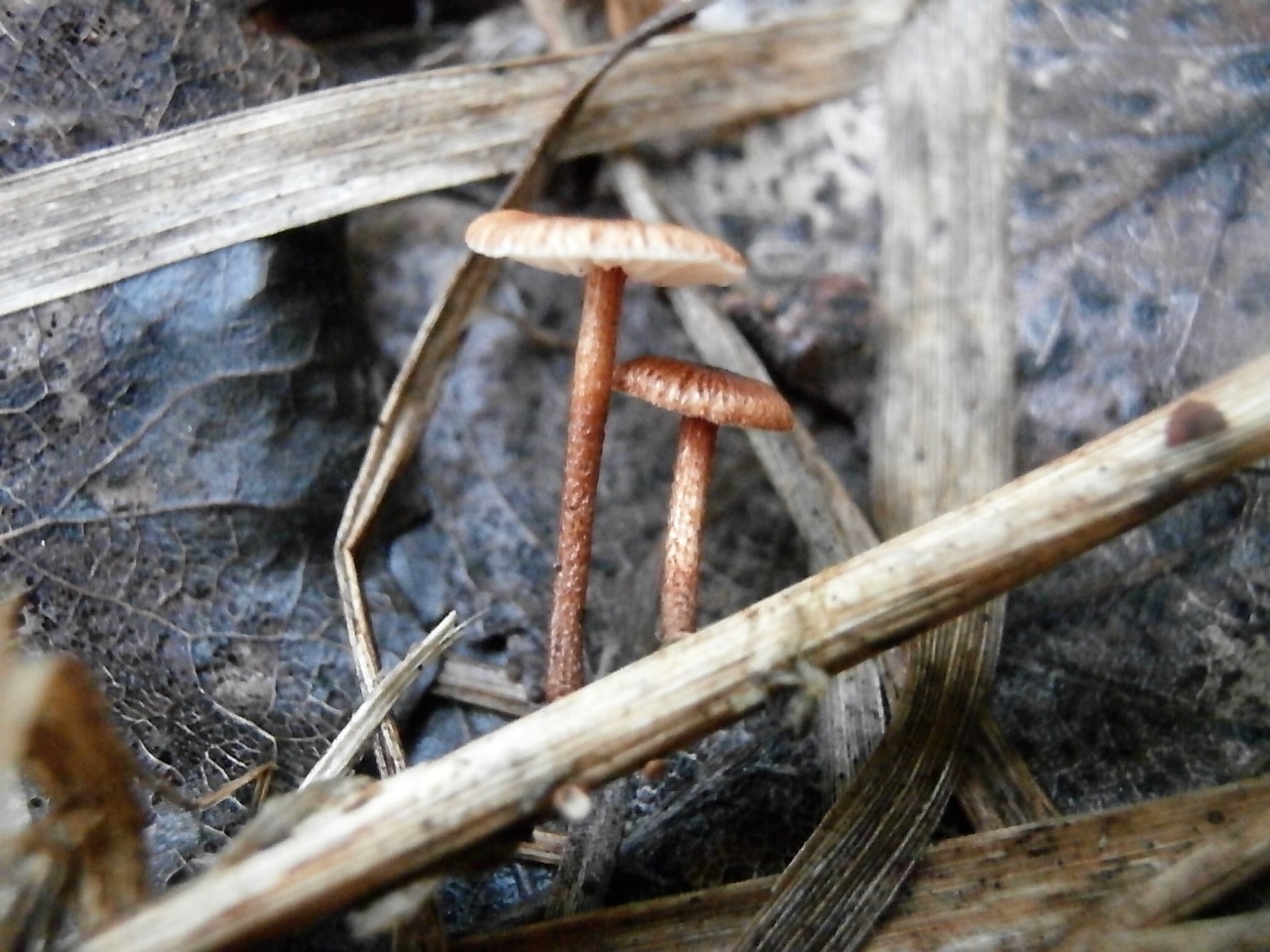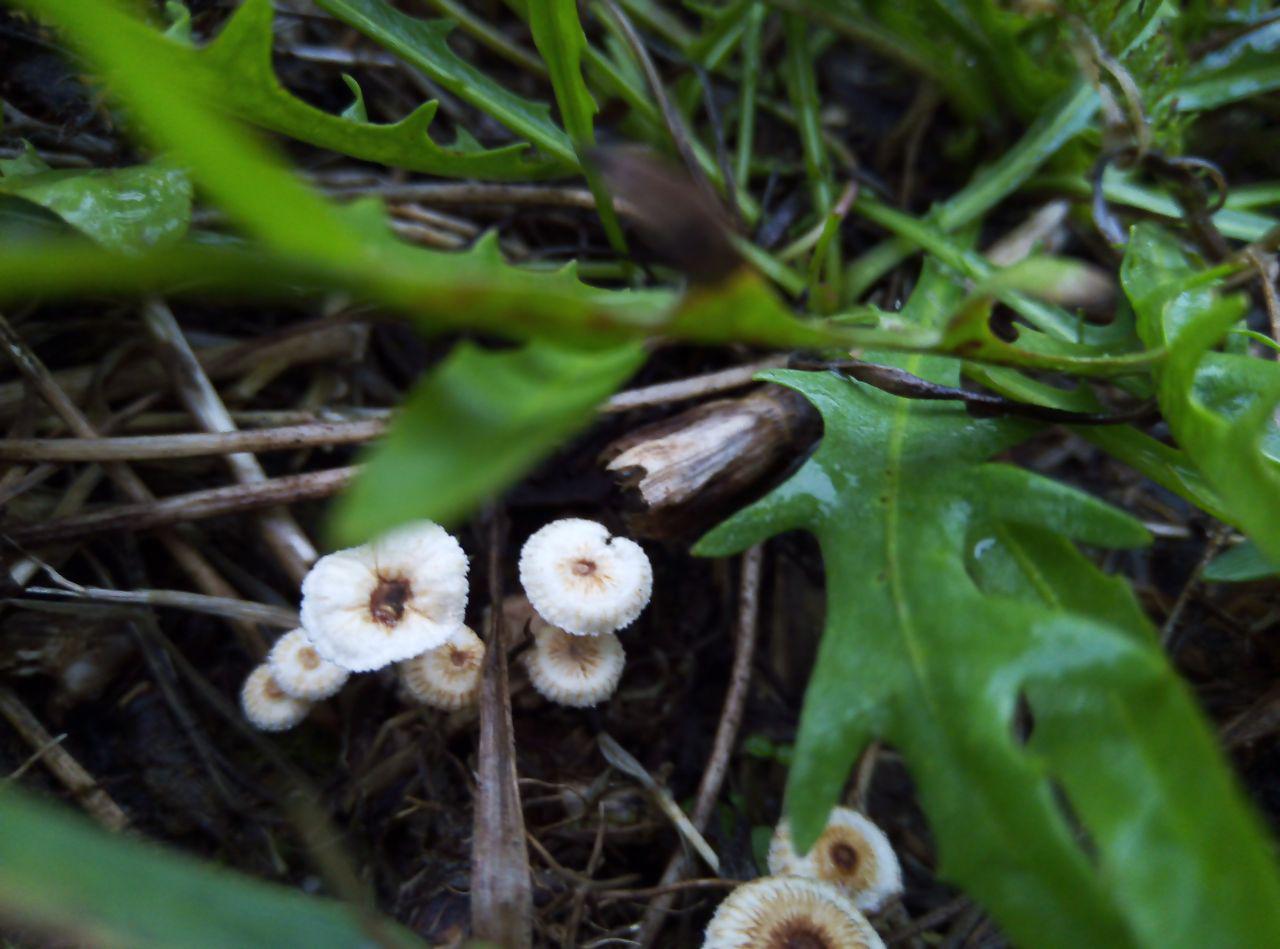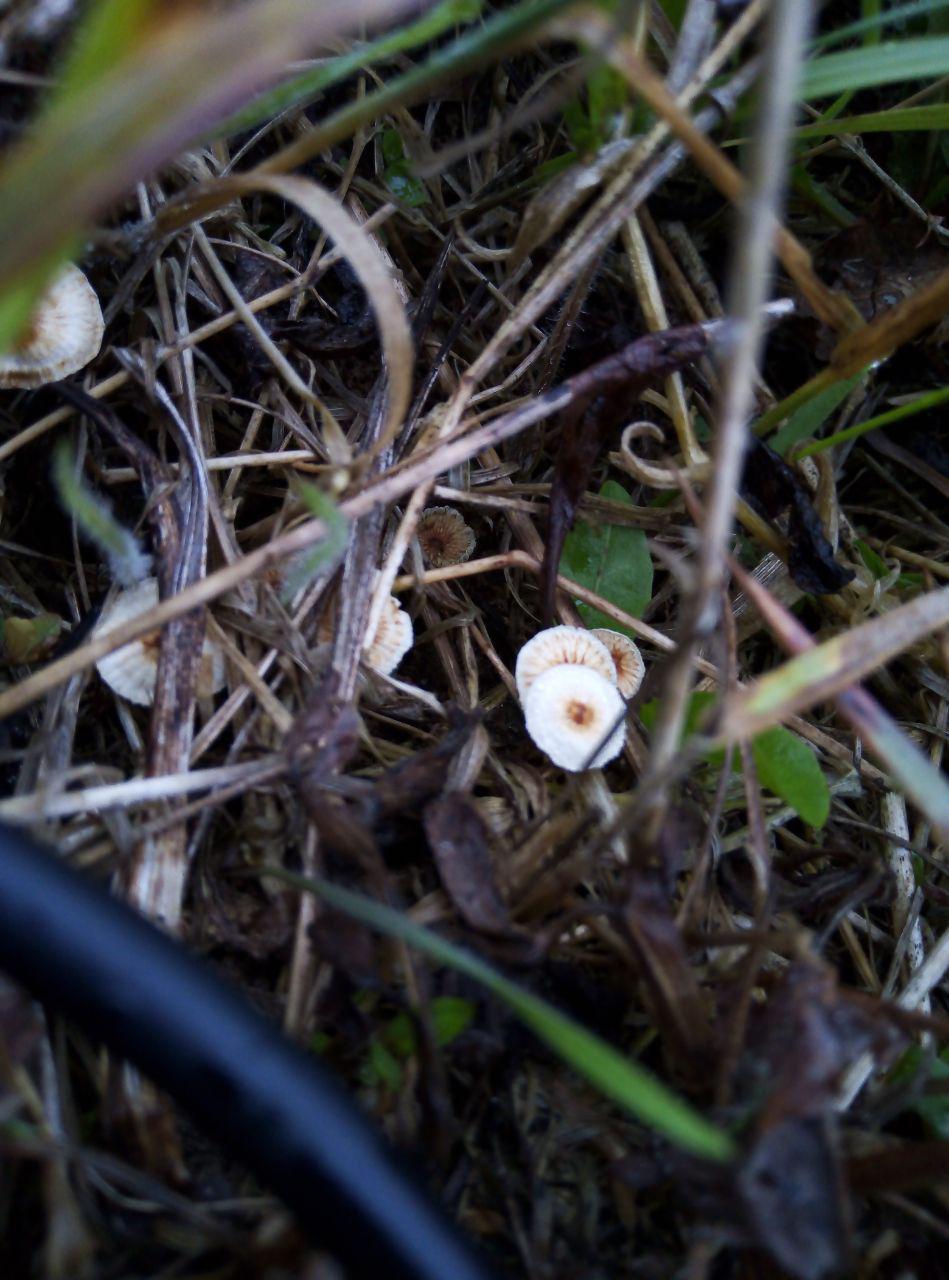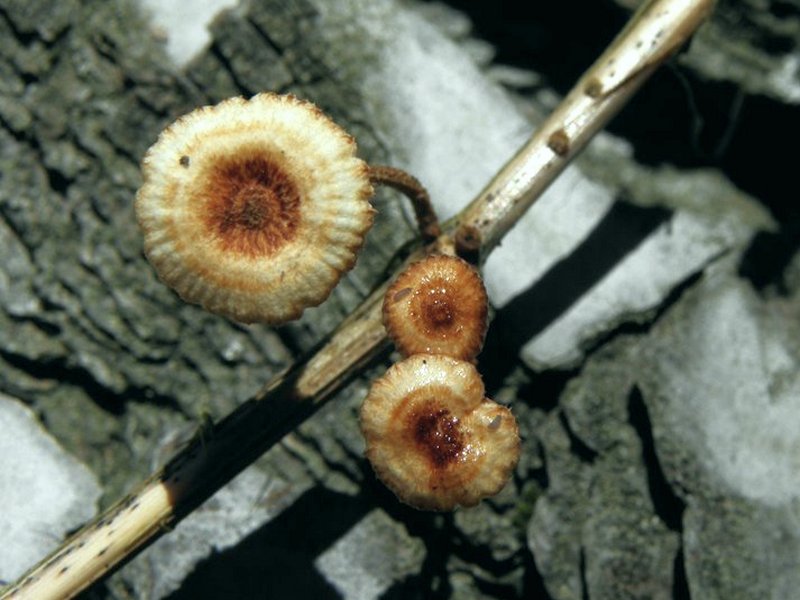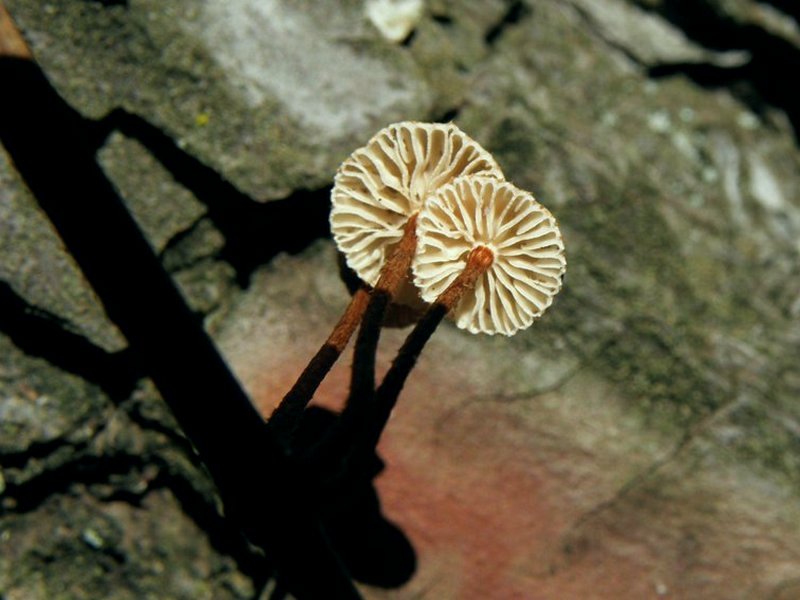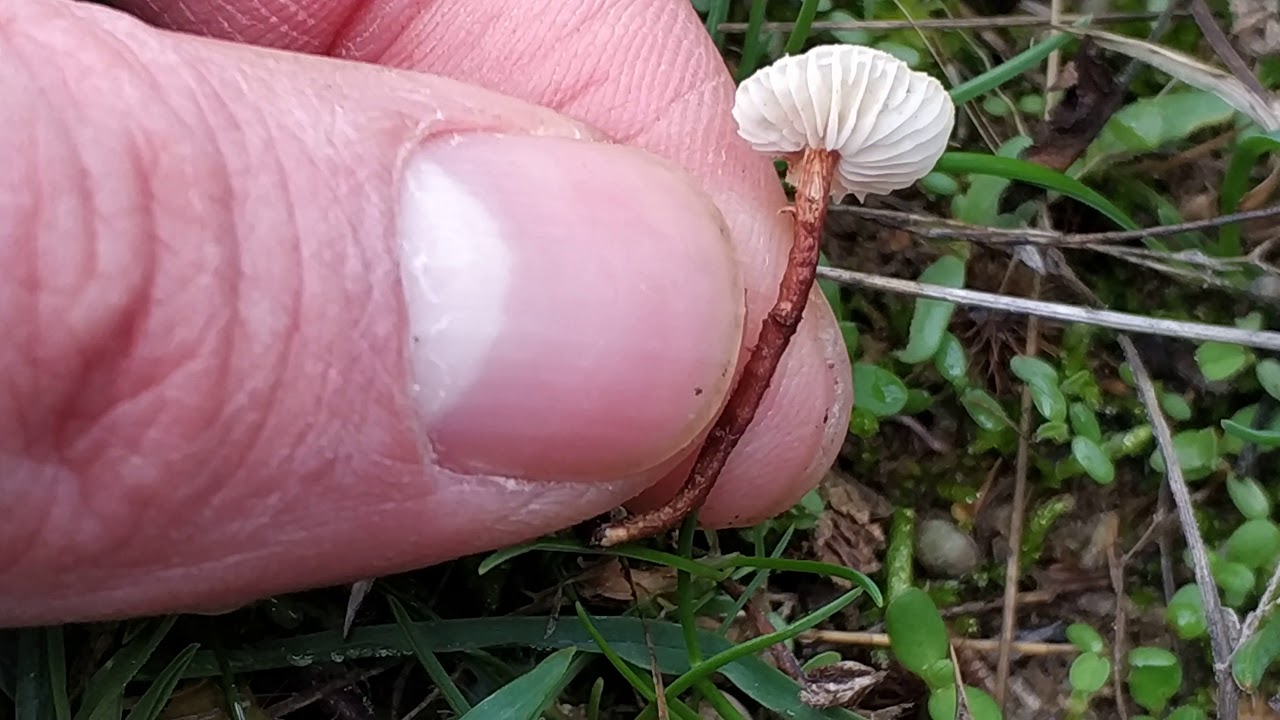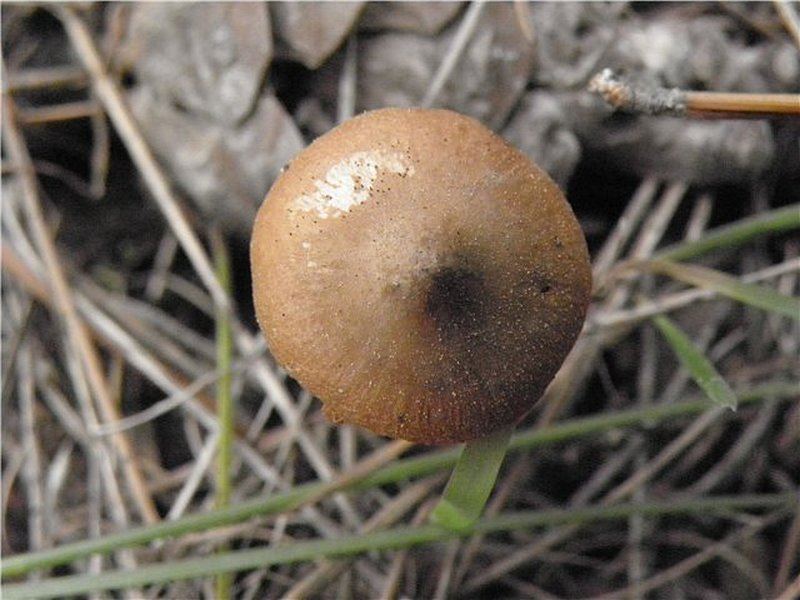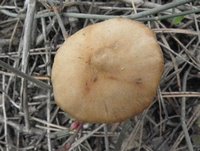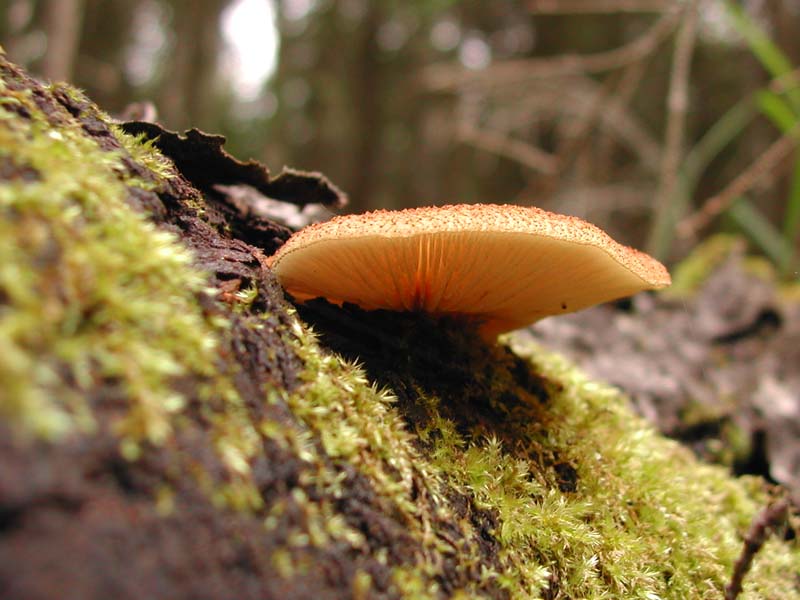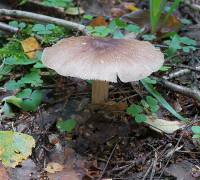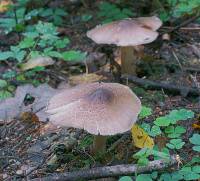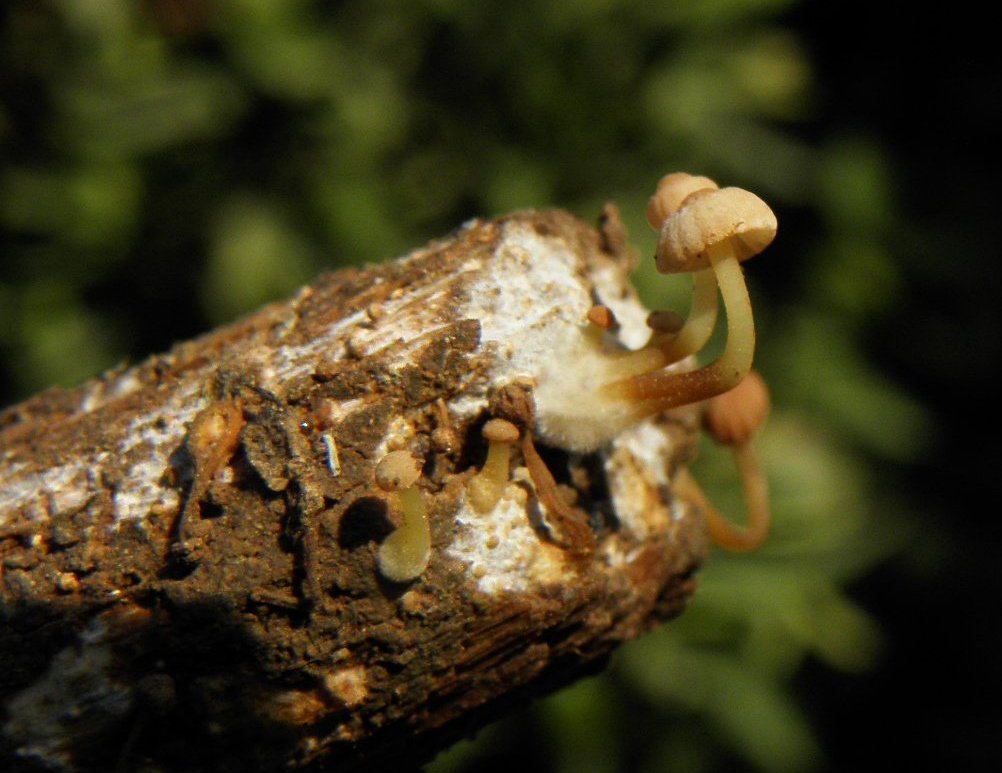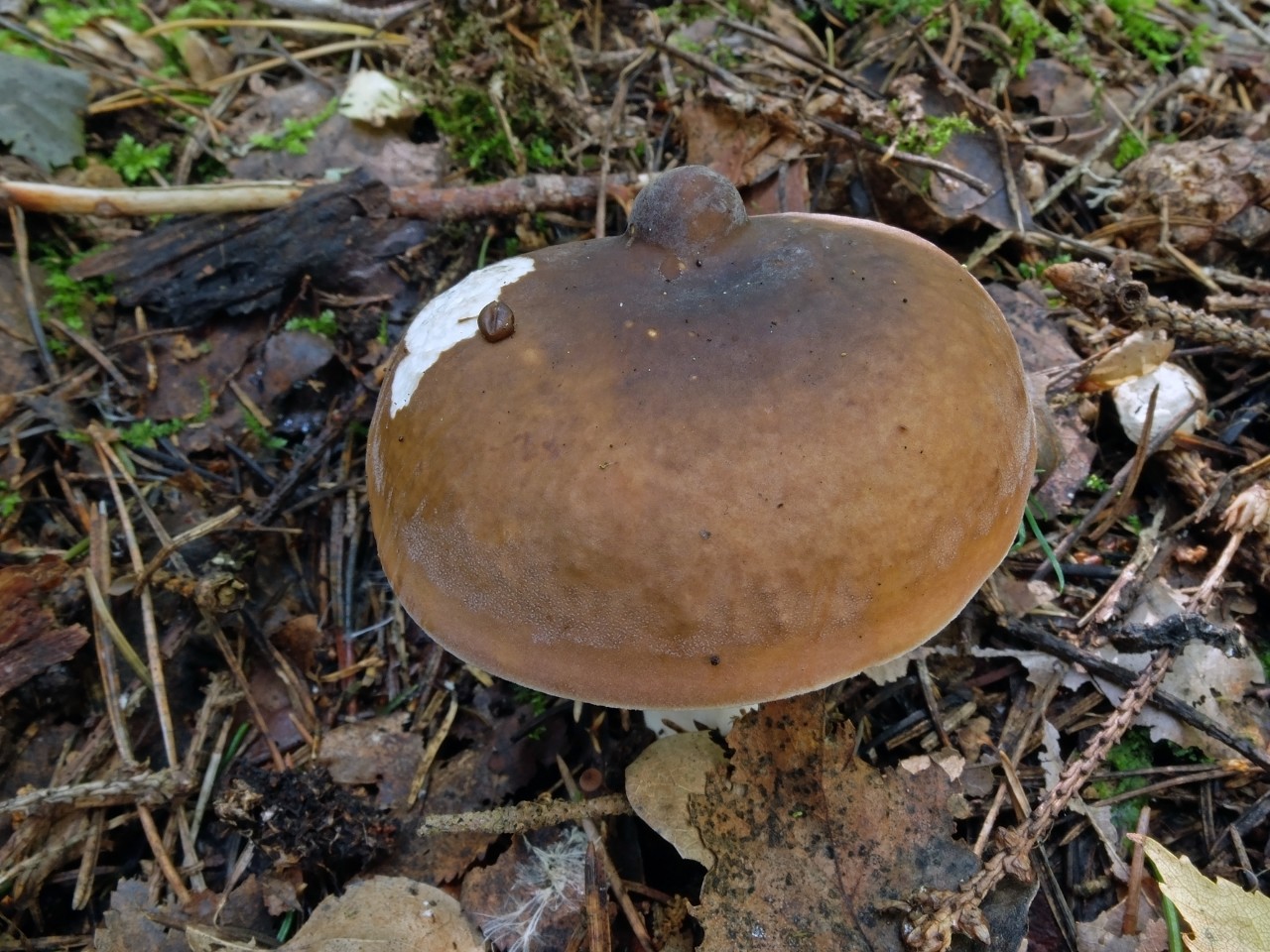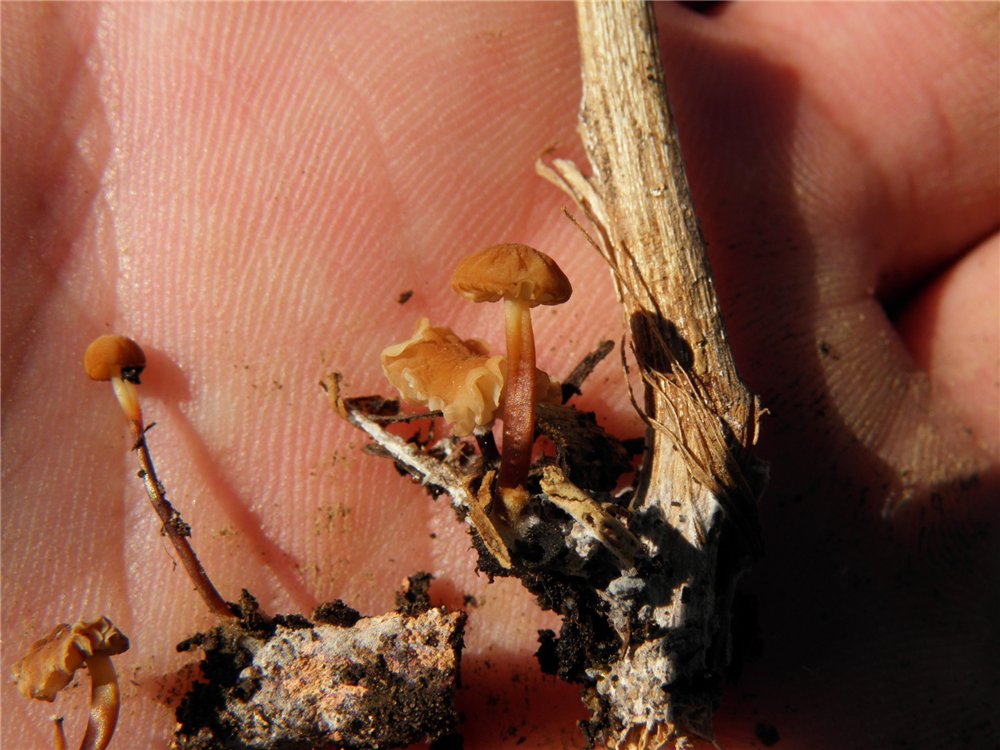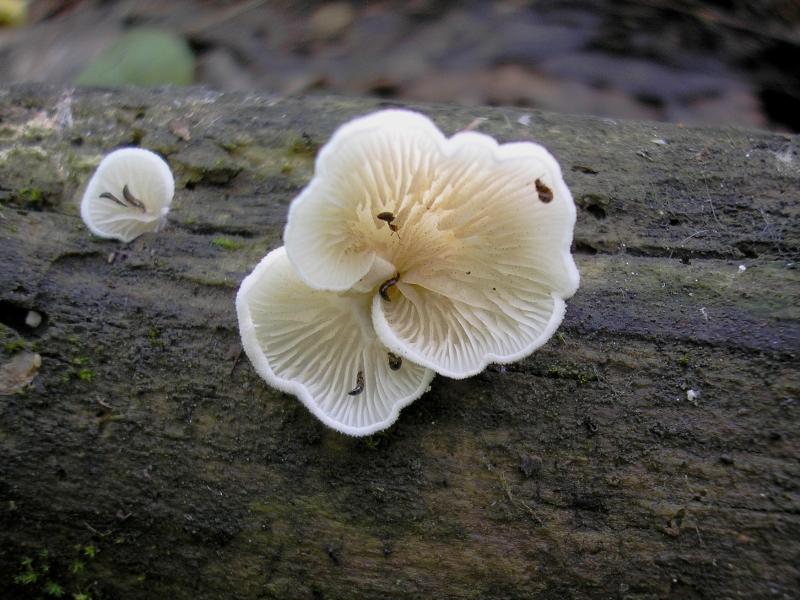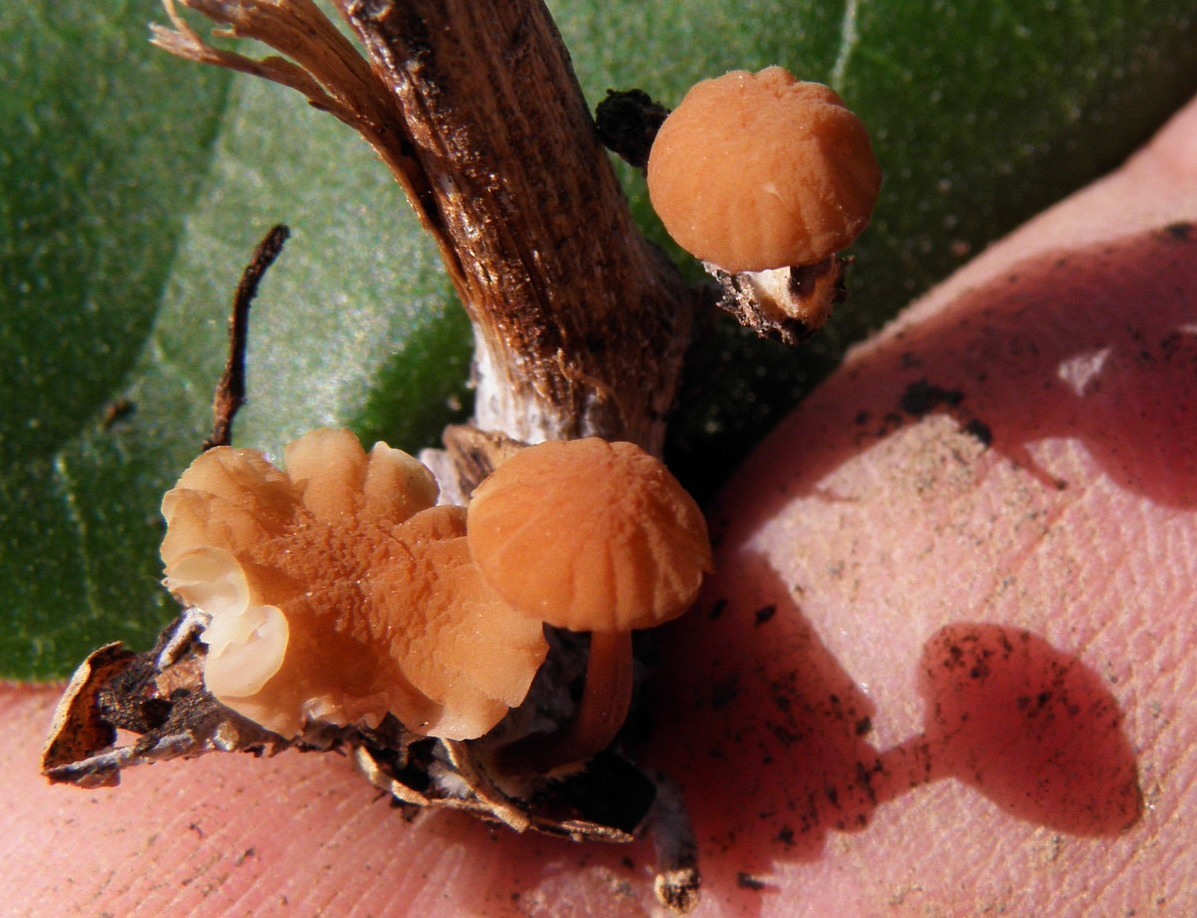Crinipellis rough: photo and description
| Name: | Crinipellis rough |
| Latin name: | Crinipellis scabella |
| Type of: | Inedible |
| Systematics: |
|
Crinipellis scabrous is also known by the Latin name Crinipellis scabella. A lamellar species from the genus Crinipellis, which is a member of the large family Negniychnikovye. Other names - Agaricus stipitarius, Marasmius epichlo, Agaricus stipitarius var. graminealis.
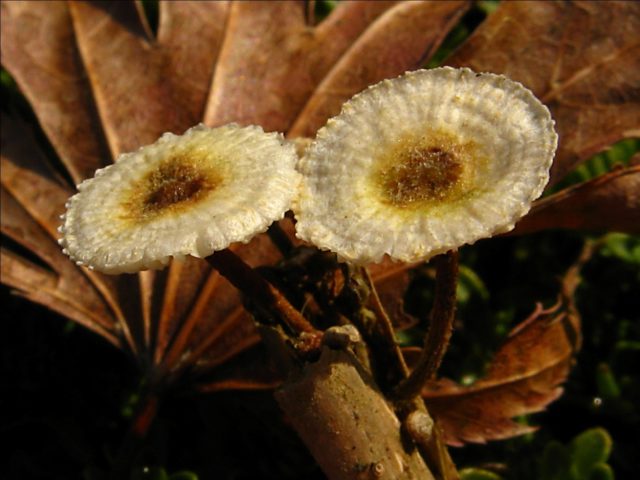
Crinipellis rough - small mushroom, consisting of a leg and a cap
What does crinipellis look like?
The species forms small fruiting bodies with fragile pulp and not uniform color. The main background of the upper part is cream or whitish with a gray tint. Center in contrasting brown or brick color.
The edges are finely scaly, the coating is dark brown with a reddish tint. Over time, the flakes crumble or fade, merging with the main tone.
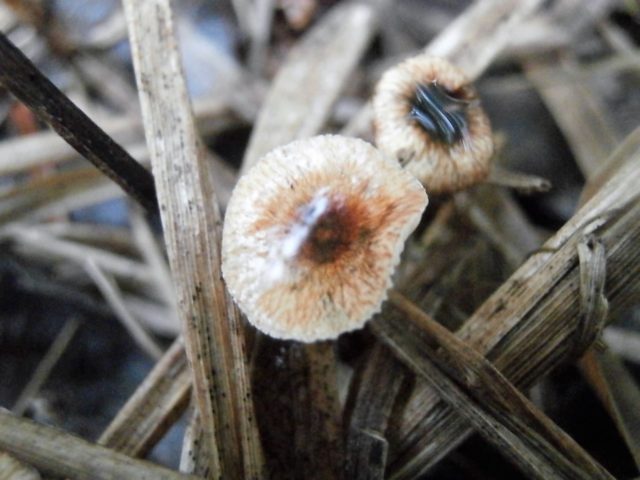
The dark fragment in the center remains unchanged with the age of the mushrooms.
Description of the hat
At the beginning of the growing season, the cap of young specimens is semicircular with concave edges and a slight conical bulge. At the next stage of development, the tubercle straightens, a shallow depression forms in its place. The adult crinipellis is scabrous with a spreading cap and clearly defined jagged edges and small cracks. The cap is generally of the correct rounded shape, less often with raised edges.
- The maximum diameter is 1.5 cm, among a kind, such mushrooms are considered large, the average size is within 0.8 cm.
- The surface is slimy in damp weather, and at low humidity it is velvety fine-flaked with longitudinal radial stripes.
- The spore-bearing layer consists of sparsely located plates descending to the stem and protruding beyond the edges of the cap, cream or light beige in color, the color does not change during the growth period.
Microscopic spores are light cream.

The pulp is springy, very fragile and thin, whitish in color
Leg description
The central leg is disproportionate to the top. It grows up to 5 cm. Slightly curved, thin, conical, thickened near the mycelium. The structure is rigid, longitudinally fibrous, hollow. The surface is covered with fine pile from below, closer to the top - with flakes.
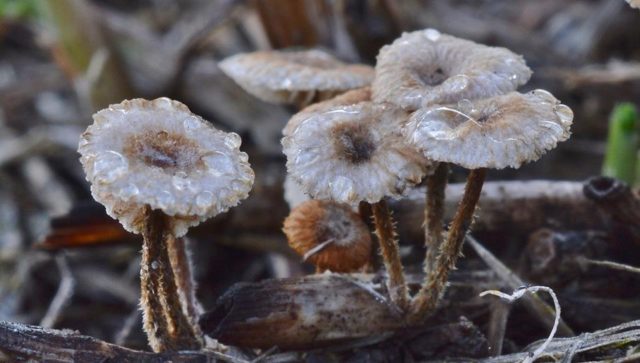
The color of the leg is dark brown, closer to black
Where and how it grows
Crinipellis is a common species, distributed throughout Russia without climatic preference. The main accumulation is in the central, European part, in the Caucasus, the Urals and Siberia. Fruiting from early summer to December in large colonies on the remains of grass, gives preference to cereals. And also on fallen leaves, forest edges.
Is the mushroom edible or not
Fruit bodies with a sweetish taste and a weak mushroom odor. Due to its small size, the mushroom has no nutritional value.
Doubles and their differences
Outwardly, the rough crinipellis looks like a wheel-shaped nonnie. Grows only on woody debris in a humid environment. Fruiting from mid-summer to autumn. Outwardly, the twin is distinguished by a pronounced ribbed surface of the cap and the absence of dark pigment in the center. Inedible species.
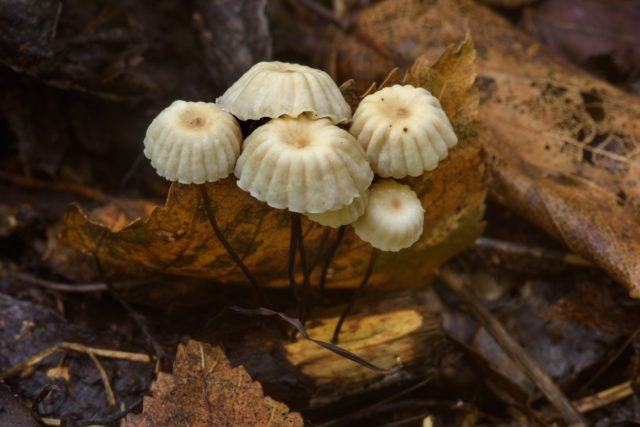
The leg is very dark, no fleecy or scaly surface, smooth
Conclusion
Crinipellis scabby is an inedible species, very small in size with a fragile, thin flesh. Fruiting from late autumn to the onset of frost in compact groups, occupies large areas, but due to its small size it is poorly visible in the grass.
Negniichnik dry: photo and description
| Name: | Dry |
| Latin name: | Marasmius siccus |
| Type of: | Inedible |
| Synonyms: | Agaricus siccus, Chamaeceras siccus |
| Systematics: |
|
Dry Negniychnikov is a member of the Negniychnikov family. The Latin name for this species is Marasmius siccus, which also has a number of synonyms: Chamaeceras siccus and Agaricus siccus.
What does a dry non-drip look like?
The mushroom is shaped like an umbrella
The fruit body of the specimen in question consists of a small cap and a long stem. The pulp is very thin, has a slight odor and a bitter taste.
Description of the hat
Always grows in large groups
At the initial stage of ripening, the cap of the dry non-pot is bell-shaped or cushion-shaped; as it grows, it acquires an almost prostrate shape. In its central part, there may be a tubercle or a pronounced flat zone, less often - a small depression. The cap is small in size, it is only 0.5 to 3 cm. It is painted in bright red-brown or orange-brown shades, it fade in old mushrooms. In the central part of the cap, the saturated color lasts longer than along its edges. The surface is smooth, dry and matt with a pronounced radial groove.
On the inner side of the cap, there are rare, almost free, or adhered toothed plates. Painted in light cream or pale yellow tones. Spores are cylindrical or fusiform, smooth, sometimes slightly curved.
Leg description
Grows throughout the summer and in the first half of autumn
For such a small cap, the leg of a dry non-nylon is considered to be rather long, the height of which ranges from 2.5 to 7 cm. Its maximum thickness in diameter reaches about 1.5 mm. It is characterized as central, rigid, straight or slightly curved, even, without bulging. The surface is shiny, smooth to the touch. The upper part of the leg is colored white or light yellow, while the lower part is dominated by dark brown or black shades. At the base there is a white felt mycelium.
Where and how it grows
The optimal time for growing is the period from June to September. Most often, dry non-nipple dwells in deciduous forests on shallow deadwood or leaf litter, less often on needles. Widely distributed in Asia, America and Europe, including Russia, Belarus and Ukraine. This species does not tend to grow one at a time, usually occurs in large groups.
Is the mushroom edible or not
Dry non-fungus belongs to the category of inedible mushrooms. Due to the small size of the fruit bodies, it has no nutritional value and is not suitable for human consumption.
Doubles and their differences
According to its external features, dry non-nipple plant is similar to the following gifts of the forest:
- Blood-headed firebrand. It is an inedible and rare species that has the ability to glow at night. You can recognize the double by a small domed red hat and a rather long stem of dark shades.
- Wheeled nonnichi - this specimen is very similar in shape and size to the described species in the shape and size of the fruiting body. However, the distinguishing feature is the color of the mushroom. So, the hat of the twin in young specimens is painted white, and in mature specimens it is grayish-yellow. Not edible.
- Smelly stinker. It belongs to the group of inedible and poisonous mushrooms. A double can be distinguished by a yellowish-brown cap and a black, shorter stem, the maximum length of which is 3 cm. In addition, this species grows on old hardwood.
Conclusion
Dry firebug is a fairly common species of the Negniychnikov family, which can be found not only in Russia, but also abroad.However, such a specimen is not of interest to mushroom pickers, since it does not represent any nutritional value.
Species
- Crinipellis actinophora
- Crinipellis albipes
- Crinipellis albocapitata
- Crinipellis alcalivirens
- Crinipellis atrovinosa
- Crinipellis australis
- Crinipellis austrorubida
- Crinipellis beninensis
- Crinipellis bisulcata
- Crinipellis brasiliensis
- Crinipellis brunneipurpurea
- Crinipellis brunneoaurantiaca
- Crinipellis brunnescens
- Crinipellis calderi
- Crinipellis calosporus
- Crinipellis campanella
- Crinipellis carecomoeis
- Crinipellis catamarcensis
- Crinipellis cervinoalba
- Crinipellis chrysochaetes
- Crinipellis commixta
- Crinipellis coroicae
- Crinipellis corticalis
- Crinipellis corvina
- Crinipellis cremoricolor
- Crinipellis cupreostipes
- Crinipellis dicotyledonum
- Crinipellis dipterocarpi
- Crinipellis dusenii
- Crinipellis eggersii
- Crinipellis excentrica
- Crinipellis filiformis
- Crinipellis foliicola
- Crinipellis furcata
- Crinipellis galeropsidoides
- Crinipellis ghanaensis
- Crinipellis glaucospora
- Crinipellis goossensiae
- Crinipellis gracilis
- Crinipellis hepatica
- Crinipellis herrerae
- Crinipellis hirticeps
- Crinipellis hygrocyboides
- Crinipellis insignis
- Crinipellis iopus
- Crinipellis kisanganensis
- Crinipellis macrosphaerigera
- Crinipellis malesiana
- Crinipellis mauretanica
- Crinipellis maxima
- Crinipellis megalospora
- Crinipellis metuloidophora
- Crinipellis mexicana
- Crinipellis mezzanensis –Italy
- Crinipellis micropilus
- Crinipellis minutula
- Crinipellis minutuloides
- Crinipellis mirabilis
- Crinipellis missionensis
- Crinipellis molfinoana
- Crinipellis multicolor
- Crinipellis nigricaulis
- Crinipellis nsimalensis
- Crinipellis ochracea
- Crinipellis ochraceopapillata
- Crinipellis omotricha
- Crinipellis pallidibrunnea
- Crinipellis palmarum
- Crinipellis patouillardii
- Crinipellis pedemontana
- Crinipellis perpusilla
- Crinipellis phyllophila
- Crinipellis piceae
- Crinipellis podocarpi
- Crinipellis procera
- Crinipellis pseudopalmarum
- Crinipellis pseudosplachnoides
- Crinipellis pseudostipitaria
- Crinipellis purpurea
- Crinipellis rhizomaticola
- Crinipellis rhizomorphica
- Crinipellis roseola
- Crinipellis roseorubella
- Crinipellis rubella
- Crinipellis rubida
- Crinipellis rubiginosa
- Crinipellis rustica
- Crinipellis sapindacearum
- Crinipellis sardoa
- Crinipellis sarmentosa
- Crinipellis scabella
- Crinipellis schevczenkoi
- Crinipellis schini
- Crinipellis septotricha
- Crinipellis sinensis
- Crinipellis siparunae
- Crinipellis squamosa
- Crinipellis stupparia
- Crinipellis substipitaria
- Crinipellis subtomentosa
- Crinipellis tabtim
- Crinipellis tenuipilosa
- Crinipellis ticoi
- Crinipellis tomentosa
- Crinipellis trichialis
- Crinipellis trinitatis
- Crinipellis tucumanensis
- Crinipellis urbica
- Crinipellis velutipes
Crinipellis scabella: how it looks, where and how it grows, edible or not
Easily overlooked, this little decomposer of hardwood debris in eastern North America features densely hairy, tawny brown surfaces. Its gills and spore print are white – and, in dry conditions, its cap often develops concentric grooves. Under the microscope it features small ellipsoid spores that are occasionally dextrinoid, odd cheilocystidia (see below), and the impressive brown hairs that characterize the genus Crinipellis. Two very similar and, in my view, questionably distinct species have been described; see the comments below if you care.
Ecology: Saprobic; growing alone or in small clusters on the woody debris of oaks and other hardwoods (sticks, logs) or rarely on decaying leaves; summer and fall; widely distributed east of the Great Plains.
Cap: 1-3 cm across (rarely to 4 cm); convex or nearly flat; usually with a distinctive, small central depression that may feature a tiny bump inside the depression; densely hairy, with the hairs often aggregating slightly to give the impression of vague radial veins; dry; tawny brown; often with obscurely concentric zones of color and texture, especially with age or in dry conditions; the margin inrolled.
Gills: Free from the stem or nearly so; crowded or close; white to ivory; not discoloring, or discoloring a little brownish.
Stem: 2-9 cm long; 1-3 mm thick; equal; dry; densely hairy; hollow; colored like the cap or darker.
Flesh: Whitish in cap; insubstantial.
Odor and Taste: Taste mild to slightly mealy; odor not distinctive, or somewhat fishy or mealy.
Chemical Reactions: KOH on cap surface flashing pink to red, then black.
Microscopic Features: Spores 5-8 x 3-5 µ; smooth; elliptical; occasionally dextrinoid. Pleurocystidia absent. Cheilocystidia variously shaped; irregular; fusiform to subclavate or cylindric overall, with one or two (rarely three) projections or sometimes vaguely lobed; to 45 x 15 µ. Pileipellis a densely tangled layer of dextrinoid, thick-walled, pointed hairs 4-8 µ wide. Clamp connections present.
REFERENCES: (Peck, 1872) Saccardo. (Kauffman, 1918; Coker & Beardslee, 1921; Phillips, 1991/2005; Lincoff, 1992; Barron, 1999; Miller & Miller, 2006; Antonin et al., 2009.) Herb. Kuo 07220307, 08040302, 07030801, 06161010.
Collybia zonata is a former name.
Crinipellis hirticeps was originally conceived as distinct from Crinipellis zonata by Peck (1907) because of its “brown color, the entire absence of zones and the longer coarser hair of the pileus” (Peck's original description of Crinipellis zonata in 1872, in putative contrast, called the cap “tawny with obscure darker zones”). Later, Singer (1942) studied herbarium specimens (but apparently not fresh material for Crinipellis hirticeps) and concluded that microscopic features separate the species: Crinipellis hirticeps features slightly larger spores (5.5-10.5 µ long) that are never dextrinoid, along with cheilocystidia that almost always branch into 2-3 appendages.
Crinipellis maxima is also virtually identical, but according to its authors (Smith and Walters, 1944) features much larger spores (8-11 µ long) that are frequently dextrinoid, and cheilocystidia that are rarely branched. Its cap is described as “somewhat zonate” and “dark yellowish brown.”
This site contains no information about the edibility or toxicity of mushrooms.
Especies
- Crinipellis actinophora
- Crinipellis albipes
- Crinipellis albocapitata
- Crinipellis alcalivirens
- Crinipellis atrovinosa
- Crinipellis australis
- Crinipellis austrorubida
- Crinipellis beninensis
- Crinipellis bisulcata
- Crinipellis brasiliensis
- Crinipellis brunneipurpurea
- Crinipellis brunneoaurantiaca
- Crinipellis brunnescens
- Crinipellis calderi
- Crinipellis calosporus
- Crinipellis campanella
- Crinipellis carecomoeis
- Crinipellis catamarcensis
- Crinipellis cervinoalba
- Crinipellis chrysochaetes
- Crinipellis commixta
- Crinipellis coroicae
- Crinipellis corticalis
- Crinipellis corvina
- Crinipellis cremoricolor
- Crinipellis cupreostipes
- Crinipellis dicotyledonum
- Crinipellis dipterocarpi
- Crinipellis dusenii
- Crinipellis eggersii
- Crinipellis excentrica
- Crinipellis filiformis
- Crinipellis foliicola
- Crinipellis furcata
- Crinipellis galeropsidoides
- Crinipellis ghanaensis
- Crinipellis glaucospora
- Crinipellis goossensiae
- Crinipellis gracilis
- Crinipellis hepatica
- Crinipellis herrerae
- Crinipellis hirticeps
- Crinipellis hygrocyboides
- Crinipellis insignis
- Crinipellis iopus
- Crinipellis kisanganensis
- Crinipellis macrosphaerigera
- Crinipellis malesiana
- Crinipellis mauretanica
- Crinipellis maxima
- Crinipellis megalospora
- Crinipellis metuloidophora
- Crinipellis mexicana
- Crinipellis mezzanensis
- Crinipellis micropilus
- Crinipellis minutula
- Crinipellis minutuloides
- Crinipellis mirabilis
- Crinipellis missionensis
- Crinipellis molfinoana
- Crinipellis multicolor
- Crinipellis nigricaulis
- Crinipellis nsimalensis
- Crinipellis ochracea
- Crinipellis ochraceopapillata
- Crinipellis omotricha
- Crinipellis pallidibrunnea
- Crinipellis palmarum
- Crinipellis patouillardii
- Crinipellis pedemontana
- Crinipellis perpusilla
- Crinipellis phyllophila
- Crinipellis piceae
- Crinipellis podocarpi
- Crinipellis procera
- Crinipellis pseudopalmarum
- Crinipellis pseudosplachnoides
- Crinipellis pseudostipitaria
- Crinipellis purpurea
- Crinipellis rhizomaticola
- Crinipellis rhizomorphica
- Crinipellis roseola
- Crinipellis roseorubella
- Crinipellis rubella
- Crinipellis rubida
- Crinipellis rubiginosa
- Crinipellis rustica
- Crinipellis sapindacearum
- Crinipellis sardoa
- Crinipellis sarmentosa
- Crinipellis scabella
- Crinipellis schevczenkoi
- Crinipellis schini
- Crinipellis septotricha
- Crinipellis sinensis
- Crinipellis siparunae
- Crinipellis squamosa
- Crinipellis stupparia
- Crinipellis substipitaria
- Crinipellis subtomentosa
- Crinipellis tabtim
- Crinipellis tenuipilosa
- Crinipellis ticoi
- Crinipellis tomentosa
- Crinipellis trichialis
- Crinipellis trinitatis
- Crinipellis tucumanensis
- Crinipellis urbica
- Crinipellis velutipes
Crinipellis rough

Crinipellis scabella (Crinipellis scabella)
- Agaricus scabellus
- Marasmius caulicinalis var. scabellus
- Marasmius scabellus
- Agaricus stipitarius
- Agaricus stipitarius var. graminealis
- Agaricus stipitarius var. corticalis
- Marasmius gramineus
- Marasmius epichlo
Description
Hat: 0.5 - 1.5 centimeters in diameter. Initially, it is a convex bell, with growth the cap becomes flat, first with a small central tubercle, then, with age, with a small depression in the center. The surface of the cap is radially wrinkled, light beige, beige, fibrous, with brownish, reddish-brown longitudinal scales, which form dark reddish-brown concentric rings. The color fades over time, becoming uniform, but the center is always darker.
Plates: adherent with a notch, whitish, creamy-whitish, rare, wide.
Leg: cylindrical, central, 2 - 5 centimeters high, thin, 0.1 to 0.3 cm in diameter. Very fibrous, straight or twisted, and feels sluggish to the touch. The color is reddish-brownish, light at the top, darker at the bottom. Covered with dark brown or brownish-reddish, darker than the cap, thin hairs.
Flesh: thin, fragile, white.
Smell and taste: not pronounced, sometimes referred to as "weak mushroom".
Spore powder: whitish. Spores: 6-11 x 4-8 microns, ellipsoidal, smooth, non-amyloid, whitish.
Ecology
Crinipellis rough - saprophyte. Grows on wood, prefers small pieces, chips, small twigs, bark. It can also grow on the herbaceous debris of various plants or other fungi. Of the herbaceous, he prefers cereals.
Season and distribution
The fungus is found quite abundantly from late spring to autumn; it is widespread in America, Europe, Asia, and possibly on other continents. It can be found in large forest clearings, forest edges, meadows and pastures, where it grows in large groups.
Etymology of the name
Crinipellis refers to the fibrous, woolly cuticle and means hair. "Scabella" means a straight stick hinting at the leg.
Similar species
Crinipellis zonata is distinguished by a sharper central tubercle and a large number of pronounced thin concentric rings on the cap.
Crinipellis corticalis - the hat is more fibrous and more pubescent. Microscopically: almond-shaped spores.
Marasmius cohaerens - more creamy and softer colors, the cap is wrinkled, but without fibers and with a very dark center, without concentric zones.
Mushroom photo Crinipellis rough from questions in recognition:


